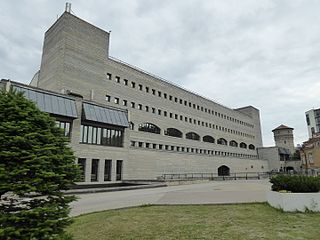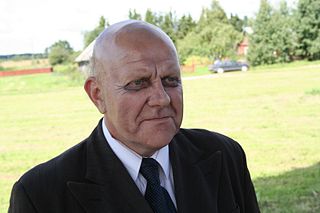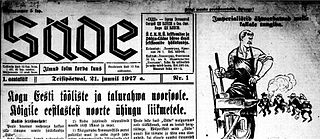This article contains information about the literary events and publications of 1906.
Tänapäev is an Estonian publishing house established in 1999 and headquartered in Tallinn. The main subjects it publishes are translated and original fiction, history, politics, biographies and children literature. In the year 2000, Tänapäev published 45 books. It published 60 books in 2001, 70 books in 2002, 86 books in 2004, and in 2012, it published about 135 books. About 2/3 of titles are translations, 1/3 Estonian originals.

Ilya Kaminsky is a USSR-born, Ukrainian-Jewish-American poet, critic, translator and professor. He is best known for his poetry collections Dancing in Odesa and Deaf Republic, which have earned him several awards.
Karl Ristikivi was an Estonian writer. He is among the best Estonian writers for his historical novels.
Estonian literature is literature written in the Estonian language The domination of Estonia after the Northern Crusades, from the 13th century to 1918 by Germany, Sweden, and Russia resulted in few early written literary works in the Estonian language. The oldest records of written Estonian date from the 13th century. Originates Livoniae in Chronicle of Henry of Livonia contains Estonian place names, words and fragments of sentences. The Liber Census Daniae (1241) contains Estonian place and family names. The earliest extant samples of connected Estonian are the so-called Kullamaa prayers dating from 1524 and 1528. The first known printed book is a bilingual German-Estonian translation of the Lutheran catechism by S.Wanradt and J. Koell (1535). For the use of priests an Estonian grammar was printed in German in 1637. The New Testament was translated into southern Estonian in 1686. The two dialects were united by Anton Thor Helle in a form based on northern Estonian. Writings in Estonian became more significant in the 19th century during the Estophile Enlightenment Period (1750–1840).

The National Library of Estonia is a national public institution in Estonia, which operates pursuant to the National Library of Estonia Act. It was established as the parliamentary library of Estonia on December 21, 1918.

Jüri Talvet is an Estonian poet and academic. He is the author of various literary works including poetry, criticism, and essays.

Mihkel Mutt is an Estonian writer, essayist, columnist and editor.

Ivan Orav is a fictional character created by Estonian writer Andrus Kivirähk, who published a book "Memoirs of Ivan Orav or the Past as Azure Mountains" in 1995. The book mocks popular stereotypes about the interbellum period of Estonian independence.

Tartu University Library is an academic library in Tartu, Estonia, belonging to the University of Tartu. It is the largest academic library in the country.

Kalle Kurg is an Estonian poet, writer, critic, translator and editor. As a versatile figure in Estonian culture, he has also published caricatures and worked as a theatre director.
Aino Pervik is an Estonian children's writer, and translator.

Liisi Ojamaa was an Estonian poet, translator, literary critic and editor. She was already known for her debut collection "Endless July", which was included in the collection "Poetry Cassette '90"; Elo Vee, Triin Soomets, Ats and Ruth Jyrjo also made their debut on the tape.

Kai Aareleid is an Estonian prose writer, poet and translator.

Epp Petrone is an Estonian writer, journalist, blogger, and publisher.
Jüri Tuulik was an Estonian writer and playwright.
Asta Põldmäe is an Estonian writer and translator.
Heldur Jõgioja was an Estonian musician, composer, writer, journalist.

Säde ('Spark') was an Estonian language youth publication issued from Leningrad, Soviet Union 1927–1929. The first issue was published on 21 June 1927. The newspaper replaced the youth magazine Säde, which had been published 1924–1926.
Siberi Tööline was an Estonian language newspaper, published from Omsk and Novonikolayevsk, Soviet Russia 1920-1922.










